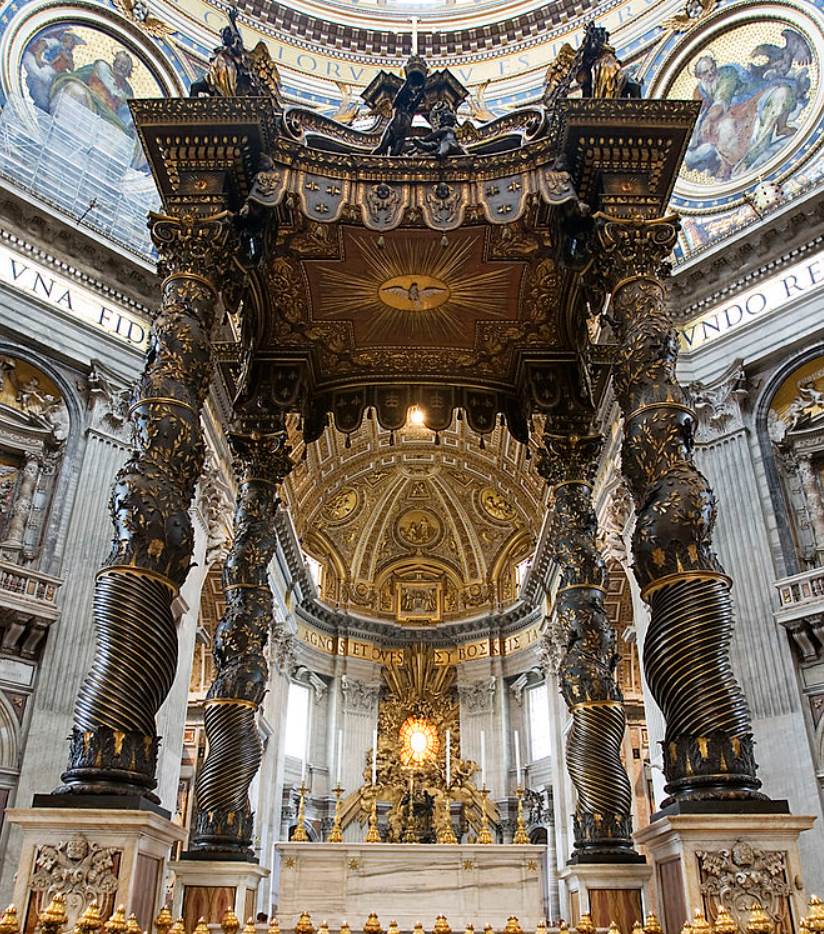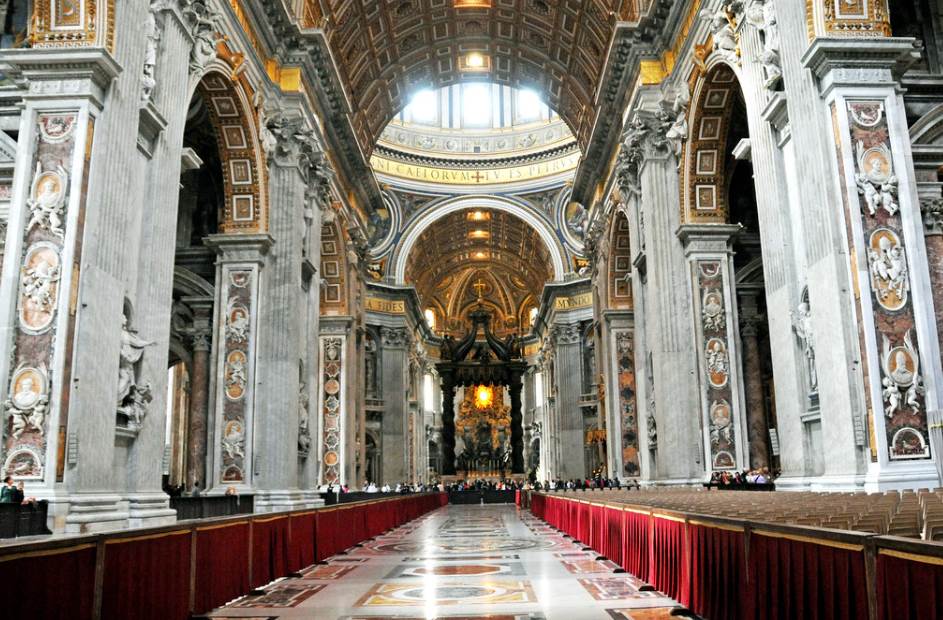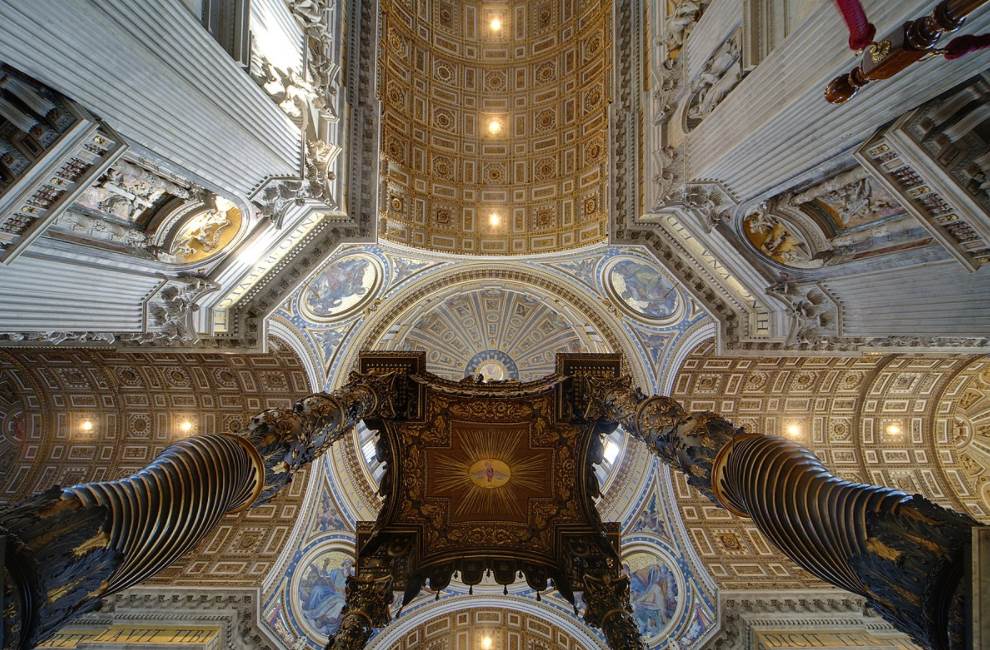When Gian Lorenzo Bernini (1598-1680) visited St Peter’s Basilica for the first time as a little boy, he had a dream to create monumental works of art to decorate it.
He not only achieved his dream and became the interior architect of the largest church in the world, but also left his permanent mark on the area by designing St Peter’s Square in front of it.
In this article, you’ll discover some of the most interesting facts about St Peter’s Baldachin, one of Bernini’s most remarkable artworks inside the church in Vatican City.
1. It serves as a decorated canopy above the high altar
St Peter’s Baldachin is a huge decorative canopy designed by one of the most renowned Baroque artists in history, Gian Lorenzo Bernini. This particular type of work is referred to as a “ciborium” or “baldachin.”
The canopy covers the high altar of St Peter’s Basilica which is located in the northern central part of the huge church. According to the original plan by Donato Bramante, the church had the shape of a Greek cross. This means the baldachin would have stood in the center.
As the construction of the Basilica progressed, it was extended southward and St Peter’s Basilica became the biggest church in the world.

2. It took over a decade to complete the work
The bronze structure consists of 4 columns that rest on marble plinths to support the cover of the high altar. Even though the structure is dwarfed by the enormous scale of the building, it’s still a monumental work of art to admire.
Bernini worked just about his whole adult life on various works of art to decorate the interior of the church. His ultimate dream came true when he earned the commission for this baldachin, the centerpiece of the church.
It took quite some time to complete as well as he worked on it between 1623 and 1634, spending over a decade to finalize this magnificent artwork.
3. The twisting columns were designed by Bernini’s predecessor
It’s impossible to imagine that one man can create such a huge work of art. That also didn’t happen because Bernini got help from multiple other artists, including his brother Luigi Bernini and his father Pietro Bernini (among multiple other Baroque sculptors).
Perhaps one of the most remarkable facts about St Peter’s Baldachin is that he can’t be the only man credited with the design of the structure as well. He got a lot of help from Francesco Borromini, a man who would become his bitter rival in the later stages of his career.
The twisting columns, a feature referred to as “Solomonic Columns” were already designed by Bernini’s predecessor as well, a man named Carlo Maderno. He was responsible for one of the least-praised features of the Basilica, the façade.

4. The plinths on which the colums rest reveal who commissioned it
The twisting columns support the canopy which covers the high altar of the Basilica. This canopy depicts the holy spirit on its interior. The columns rest on 4 marble plinths which are decorated as well.
The Baldachin was commissioned by Pope Urban VIII (1568-1644), a man who was born Maffeo Barberini. The exterior of these plinths is decorated with the coats of arms of the House of Barberini, an influential family during the 17th century in Rome.
5. The bronze Baldachin is huge (and it needed to be)
You have to see St Peter’s Basilica to appreciate the sheer size of this building. This also reflects in a very spacious interior which required artworks of an equally monumental scale in order not to pale in comparison.
This means that the Baldachin is pretty huge as the columns alone stand over 20 meters (66 feet) tall. The entire structure reaches a height of 28.74 meters (94.3 feet).
With a length of 220 meters (720 feet), a width of about 150 meters (490 feet), and a nave height of 46.2 meters (152 feet), the enormous artwork still looks relatively small from a distance, quite incredible indeed!

More interesting facts about St Peter’s Baldachin
6. Even though St Peter’s Baldachin is the largest of its kind in the world, the structure itself was far from unique. In fact, most churches and basilicas in Rome had a baldachin covering their altar at the time.
The Old St Peter’s Basilica also had a baldachin which featured Solomonic columns. 8 of the original columns inside the demolished Basilica were used to build the piers of the baldachin in the new Basilica.
7. During the Middle Ages, it was believed that the original columns of St Peter’s Baldachin were brought to Rome from Jerusalem. It was believed that these columns once decorated the Temple of Solomon in this Holy City.
The truth, however, is that they were most probably brought to Rome from Greece by Roman Emperor Constantine I in the early 4th century. This is for the simple fact that they were built using Greek marble.

8. The underside of the canopy is decorated with radiating beams. This is directly below where the Pope performs his duties during official ceremonies.
This emblem is not just another symbol of the Barberini Family, but devout Christians also believe that the Holy Spirit resides in this area.
9. It remains unclear until today where the huge amount of bronze to sculpt this work of art came from. Contemporary sources even accused Pope Urban VIII that he took the bronze from inside the portico of the Roman Pantheon, a structure dating back to Roman times.
His accounts claim that he used most of this bronze to build a huge cannon instead, while the bronze to build St Peter’s Baldachin was imported from Venice. The truth regarding this issue is still out there.
10. The location of the high altar in the center of the crossing of the church isn’t a usual one. In most Latin Cross churches, the altar is located at the end of the church, not in the center.
Gian Lorenzo Bernini eventually solved this problem by creating yet another monumental work of art called the “Chair of Saint Peter” or the “Cathedra Petri.”
This enormous shrine presumably features the wooden chair of Saint Peter himself. Bernini created an elaborately bronze casing between 1657 and 1666, a work of art that completed the visual aspect of the interior design of St Peter’s Basilica.



